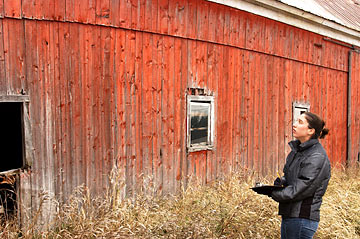Table of Contents
As Big As All Outdoors
Turn Left in Bismarck, and Go Until…
Relax! We Have New Labs for That
Fieldwork Across the Curriculum:
Update on ISEI
Letter from James Costopoulos '83
As Big As All Outdoors
In field-based courses, students learn things they never could in a classroom.By Macreena A. Doyle
Megan Thomas '04, a student in Glenn Harris's course Seeing History, ponders what stories a weathered North Country barn might tell. The Exotic Supermarket
If you think that exotic ingredients carried in your local supermarket could only be found in the produce or ethnic food aisles, think again. That's what students in Assistant Professor of Biology Carlos Ramirez-Sosa's Ethnobotany course learned, in one of their many field trips – to the P&C, about a half-mile from campus in Canton.That part of the course, which focuses on the use of plants by native peoples all over the world, examines the world in the market, literally. Students fan out in the store, poring over product labels, and determine where various ingredients originated.
“The course introduces students to exotic plants, but also shows them the importance of local plants,” Ramirez-Sosa says. “They discover the diversity of plants right in this region, and all the many uses there are for them.”
Get Out!
You may have heard that the entire world is a classroom. Few have taken that to heart as avidly as Professor and Chair of Environmental Studies Glenn Harris, who teaches an entire course outdoors. It’s one that defines “environmental studies” a little differently.
“How do you get people interested in history? That's a big question for me,” Harris told The Chronicle of Higher Education of his course Seeing History. “One of the ways to do it is to get out of the classroom and into the field.”And “into the field” they go, for every class – to the National Gallery in Ottawa; to the Adirondack Museum in Blue Mountain Lake; to local parks; to abandoned agricultural land; to “blowdown” areas near Cranberry Lake in the Adirondacks; to an abandoned mine and a shut-down paper factory; to old barns; to small-town Main Streets in Madrid, Lisbon and Canton (the ones in St. Lawrence County, not Spain, Portugal and China respectively); to witness the planning and development efforts of the small city of Ogdensburg; to the Canadian side of the St. Lawrence Seaway and other locations in the region, to “read” the natural and cultural landscape.
A Penny for Their Thoughts
Even when you're standing on top of it, it’s hard to imagine how a giant sand dune wound up in Parishville, N.Y., less than half an hour from the St. Lawrence campus. And if you can only see pictures of it, it's practically impossible.That's why the students in Assistant Professor of Geology Stephen Robinson's Geomorphology class take a field trip every week, to somewhere in St. Lawrence County or beyond.
“There’s no substitute for field study,” Robinson says. “You can't bring the entire sand dune or boulder, and its surroundings, back to the lab. When you can actually lecture on-site, and have the students take in the whole environment, that's when they get it.”
Other courses with significant field components:
Biology 221, General Ecology
Non-Departmental 247A, Field Methods for Environmental Science
Geology 314, Glacial and Quaternary Geology
Geology 216, Sedimentology
Geology 206, Invertebrate Paleontology
Biology 207, Freshwater Biology
